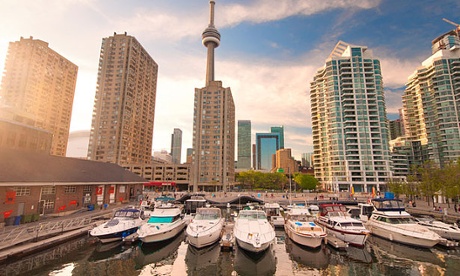
Toronto has never been a visual stunner. Filmmakers often use its generic cityscape to stand in for other locations. But North America’s largest urban revitalisation project is set to to change that.
The 25-year Waterfront Toronto project will see 800 hectares of land (1,976 acres or four times the size of Monaco) developed at a cost of $34bn dollars. It started in 2002, and a significant step has just been reached with the reopening in June of Queen’s Quay, by Lake Ontario, after three years of construction work that has completely reimagined Toronto’s car-centric urban landscape.
A democratic blend of pavement, bicycle lane, light railway and car, it’s a humane artery connecting the many parks and cultural institutions along the water’s edge. Brittany Holliss, manager of operations at the Museum of Inuit Art, was surprised how quickly things took off when the quay opened: “From the different events and ways I’ve already seen the space being used – there are always people using the bike lanes – I’m pretty excited to see what comes next. The waterfront is such a gorgeous area to work and live in, so it’s great that there are more things for visitors to discover.”
New additions to the waterfront over recent years include two public squares at the Harbourfront Centre, the area’s cultural hub. With farmers’ markets, concerts and art exhibitions, it’s the second most-visited place in the city after the CN Tower. Festivals such as Nuit Blanche and the International Festival of Authors draw the crowds, as does the Sur Gallery of contemporary Latin American art, opened recently close to the long-established Power Plant gallery. The two-year-old Amsterdam Brewhouse has become a popular lakeside craft beer destination.
Further east, the Don river snakes from the harbour past Toronto’s newest neighbourhood, the Canary District, which was built from scratch as part of Waterfront Toronto’s masterplan. It is so new that the public will have to wait until the end of August to explore the area fenced off for the Pan Am and Parapan Am Games athletes’ village. When it’s occupied next spring, visitors will find a recreation centre and spa as well as promenades and squares full of public art and lined with cafes, restaurants and shops.
“It will be a fabulous place just to go walking, or for coffee, a drink or dinner,” says Christopher Glaisek, vice- president of planning and design at Waterfront Toronto. The promise of thousands of new residents has recently attracted restaurants such as Corktown Kitchen and Roselle Desserts, which both opened this spring in this once low-key area.
But the greatest ambitions lie further east, beyond the East Bayfront Promenade along the lake, where the patio of waterside pub Against the Grain has become a coveted perch. In a decade, if all goes to plan (including a billion dollar rerouting of the mouth of the Don), the last remaining dockland area (about the size of London’s Canary Wharf) will become a quilt of communities and parks on the water’s edge, and possibly the site for Expo 2025 – if Toronto decides to bid. Toronto’s days of urban generic could be over. “This is a lucky time for the city,” says Glaisek.

